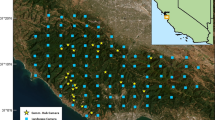Abstract
We investigated field-based recruitment via visual, chemical and acoustic cues provided by conspecific wasps on carbohydrate feeders in Vespula koreensis. A wild colony nest was excavated and artificially installed in a field site. Naïve foragers were individually marked and trained to an experimental feeder. We conducted three separate experiments in which foragers were presented with feeder dishes with different cue intensities. For the first, a different number of decoys were posed as if feeding (visual cue). In the second, dishes had been previously visited by different numbers of individuals, thus presenting different concentrations of a possible food site marking substance (chemical cue). In the third, each dish was placed in front of a covered flask with a different number of nestmates inside (acoustic cue combined with body-odor cue). We observed no social facilitation or social inhibition due to any of the experimental cues. Previous studies in Vespula species have shown a variety of foraging strategies ranging from local enhancement to local inhibition. Field-based recruitment mechanisms in yellowjackets may have evolved independently in different lineages.



Similar content being viewed by others
References
Beier W (1983) Beobachtungen und Experimente zur Orientierung der deutschen Wespe (Paravespula germanica) am Futterplatz. Zool Beitr 28:321–348
Camazine S, Deneubourg JL, Franks NR, Sneyd J, Theraulaz G, Bonabeau E (2001) Self-organization in biological systems. Princeton University Press, Princeton
Carpenter JM (1987) Phylogenetic relationships and classification of the Vespinae (Hymenoptera: Vespidae). Syst Entomol 12:413–431
Clayton DA (1978) Socially facilitated behavior. Q Rev Biol 53:373–392
D’Adamo P, Lozada M (2005) Conspecific attraction as a social communication mechanism in the wasp Vespula germanica, and its possible contribution to its control. Ann Entomol Soc Am 98:236–40
D’Adamo P, Corley J, Sackmann P, Lozada M (2000) Local enhancement in the wasp Vespula germanica: are visual cues all that matter? Ins Soc 47:289–291
D’Adamo P, Lozada M, Corley J (2003) Conspecifics enhance attraction of Vespula germanica (Hymenoptera: Vespidae) foragers to food baits. Ann Entomol Soc Am 96:685–688
Dechaume-Moncharmont FX, Dornhaus A, Houston AI, McNamara JM, Collins EJ, Franks NR (2005) The hidden cost of information in collective foraging. Proc Roy Soc Lond B Biol Sci 272:1689–1695
Giraldeau LA, Caraco T (2000) Social foraging theory. Princeton University Press, Princeton
Greene A (1991) Dolichovespula and Vespula. In: Ross KG, Matthews RW (eds) The social biology of wasps. Cornell University Press, Ithaca, pp 263–305
Hölldobler B (1984) Evolution of insect communication. In: Lewis T (ed) Insect communication. The Royal Entomological Society of London. Academic, London, pp 349–377
Hölldobler B, Wilson EO (1990) The ants. Harvard University Press, Cambridge
Hrncir M, Jarau S, Zucchi R, Barth FG (2004) On the origin and properties of scent marks deposited at the food source by a stingless bee, Melipona seminigra. Apidologie 35:3–13
Jandt JM, Riel L, Crain B, Jeanne RL (2005) Vespula germanica foragers do not scent-mark carbohydrate food sites. J Ins Behav 18(1):19–31
Jeanne RL (1980) Evolution of social behavior in the Vespidae. Annu Rev Entmol 25:371–396
Jeanne RL (1991) The swarm-founding Polistinae. In: Ross KG, Matthews RW (eds) The social biology of wasps. Cornell University Press, Ithaca, pp 191–231
Jeanne RL (1999) Group size, productivity, and information flow in social wasps. In: Detrain C, Deneubourg JL, Pasteels JM (eds) Information processing in social insects. Birkhäuser, Basel, pp 3–30
Kim TW, Kim KW, Srygley RB, Choe JC (2004) Semilunar courtship rhythm of the fiddler crab Uca lactea in a habitat with great tidal variation. J Ethol 22:63–68
Kurta A (1982) Social facilitation of foraging behavior by the hermit crab, Coenobita compressus, in Costa Rica. Biotropica 14:132–136
O’Donnell S (1998) Reproductive caste determination in eusocial wasps (Hymenoptera: Vespidae). Annu Rev Entmol 43:323–46
Overmyer SL (1995) Scent-mediated recruitment and food site marking in the German yellowjacket, Vespula germanica (Hymenoptera: Vespidae). Master’s Thesis, University of Wisconsin-Madison, Wisconsin
Parrish MD, Fowler HG (1983) Contrasting foraging related behaviours in two sympatric wasps (Vespula maculifrons and V. germanica). Ecol Entomol 8:185–190
Reid BL, MacDonald JF, Ross DR (1995) Foraging and spatial dispersion in protein-scavenging workers of Vespula germanica and V. maculifrons (Hymenoptera: Vespidae). J Ins Behav 8:315–330
Raveret Richter MA (2000) Social wasp (Hymenoptera: Vespidae) foraging behavior. Annu Rev Entmol 45:121–150
Raveret Richter MA, Tisch VL (1999) Resource choice of social wasps: influence of presence, size and species of resident wasps. Ins Soc 46:131–136
SAS Institute (1998) StatView 5.0. SAS Institute, Cary
Schmitz J, Moritz RFA (1998) Molecular phylogeny of Vespidae (Hymenoptera) and the evolution of sociality in wasps. Mol Phylogenet Evol 9:183–191
Seeley TD (1995) The wisdom of the hive: the social physiology of honeybee colonies. Harvard University Press, Cambridge
Slaa EJ, Wassenberg J, Biesmeijer JC (2003) The use of field-based social information in eusocial foragers: local enhancement among nestmates and heterospecifics in stingless bees. Ecol Entomol 28(3):369–379
Smith AR, O’Donnell S, Jeanne RL (2002) Evolution of swarm communication in eusocial wasps (Hymenoptera: Vespidae). J Ins Behav 15:751–64
Stout JC, Goulson D (2001) The use of conspecific and interspecific scent marks by foraging bumblebees and honeybees. Anim Behav 62:183–189
Thorpe WH (1963) Learning and instinct in animals. Harvard University Press, Cambridge
Yu HS (1994) Check list of insects from Korea. The Entomological Society of Korea, Kon-kuk University Press, Seoul
Acknowledgements
We thank Dong Hwan Choe and Hyo Jeong Park for field assistance and Jeong Kyu Kim for identification of the species. We also thank Robert Srygley, Piotr Jablonski, Tae Won Kim and Charles Henry for proving invaluable comments on earlier drafts. This study was supported by BK21 Research Fellowship from the Korean Ministry of Education, and Korea Science and Engineering Foundation (R08-2003-000-10367-0).
Author information
Authors and Affiliations
Corresponding author
About this article
Cite this article
Kim, K.W., Noh, S. & Choe, J.C. Lack of field-based recruitment to carbohydrate food in the Korean yellowjacket, Vespula koreensis . Ecol Res 22, 825–830 (2007). https://doi.org/10.1007/s11284-006-0324-1
Received:
Accepted:
Published:
Issue Date:
DOI: https://doi.org/10.1007/s11284-006-0324-1




